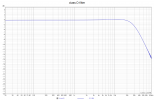- Thread Starter
- #61
I was unaware that they could pull 1 ohm. More & more I am starting to see a reason to switch. Perhaps when I (if) retire in 2 years...I may switch. Or get one for the subs & then, later one for each channel.
You will find the info on minimum allowed load impedance in a datasheet of the product, if it is a trustworthy and reliable manufacturer, like Hypex is. Please find several examples below.
However, not every manufacturer is providing such info. That might be a hint, if you are seeking for a reliable product.
It may seem to be unimportant, but it is not. The EPDR (equivalent power dissipation resistance) of event the speakers that may seemingly appear as a light load often falls down to 2 ohm or lower. As an example, below is an impedance plot of my 3-way Quadral Ascent 90 speaker. Though the impedance magnitude is everywhere above 3.7 ohm, EPDR falls down to 2.4 ohm. People often forget or cannot read the influence of phase response, they just look to magnitude response only. Then surprised with some speakers and amplifier failure.
Last edited:




